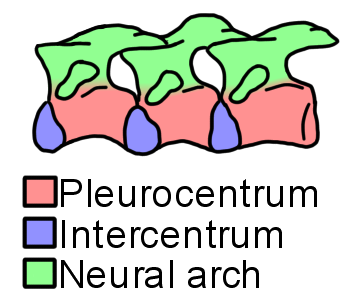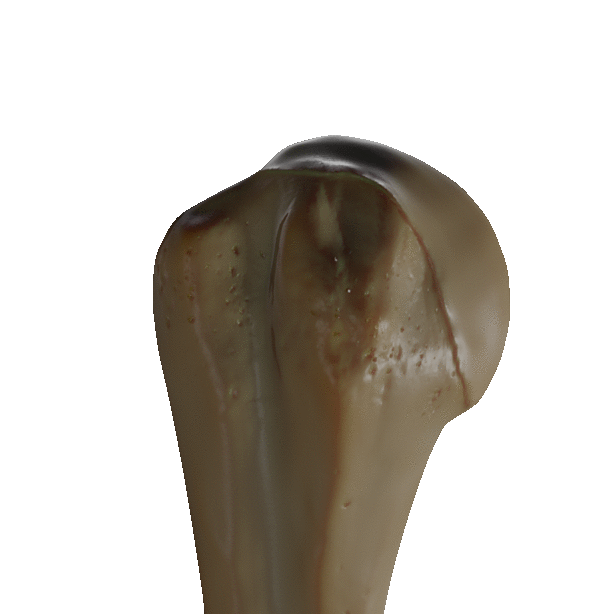|
Trihecaton
''Trihecaton'' is an extinct genus of microsaur from the Late Pennsylvanian (geology), Pennsylvanian of Colorado. Known from a single species, ''Trihecaton howardinus'', this genus is distinctive compared to other microsaurs due to possessing a number of Plesiomorphy and symplesiomorphy, plesiomorphic ("primitive") features relative to the rest of the group. These include large intercentra (wedge-like components of the vertebrae), folded Tooth enamel, enamel, and a large Coronoid process of the mandible, coronoid process of the jaw. Its classification is controversial due to combining a long body with strong limbs, features which typically are not present at the same time in other microsaurs. Due to its distinctiveness, ''Trihecaton'' has been given its own Monotypic taxon, monospecific family (biology), family, Trihecatontidae. Discovery ''Trihecaton'' is known from well-preserved fossils discovered in Fremont County, Colorado, Fremont County, Colorado by a University of Califo ... [...More Info...] [...Related Items...] OR: [Wikipedia] [Google] [Baidu] |
Genus
Genus ( plural genera ) is a taxonomic rank used in the biological classification of living and fossil organisms as well as viruses. In the hierarchy of biological classification, genus comes above species and below family. In binomial nomenclature, the genus name forms the first part of the binomial species name for each species within the genus. :E.g. '' Panthera leo'' (lion) and '' Panthera onca'' (jaguar) are two species within the genus ''Panthera''. ''Panthera'' is a genus within the family Felidae. The composition of a genus is determined by taxonomists. The standards for genus classification are not strictly codified, so different authorities often produce different classifications for genera. There are some general practices used, however, including the idea that a newly defined genus should fulfill these three criteria to be descriptively useful: # monophyly – all descendants of an ancestral taxon are grouped together (i.e. phylogenetic analysis should c ... [...More Info...] [...Related Items...] OR: [Wikipedia] [Google] [Baidu] |
Holotype
A holotype is a single physical example (or illustration) of an organism, known to have been used when the species (or lower-ranked taxon) was formally described. It is either the single such physical example (or illustration) or one of several examples, but explicitly designated as the holotype. Under the International Code of Zoological Nomenclature (ICZN), a holotype is one of several kinds of name-bearing types. In the International Code of Nomenclature for algae, fungi, and plants (ICN) and ICZN, the definitions of types are similar in intent but not identical in terminology or underlying concept. For example, the holotype for the butterfly '' Plebejus idas longinus'' is a preserved specimen of that subspecies, held by the Museum of Comparative Zoology at Harvard University. In botany, an isotype is a duplicate of the holotype, where holotype and isotypes are often pieces from the same individual plant or samples from the same gathering. A holotype is not necessaril ... [...More Info...] [...Related Items...] OR: [Wikipedia] [Google] [Baidu] |
Basal (phylogenetics)
In phylogenetics, basal is the direction of the ''base'' (or root) of a rooted phylogenetic tree or cladogram. The term may be more strictly applied only to nodes adjacent to the root, or more loosely applied to nodes regarded as being close to the root. Note that extant taxa that lie on branches connecting directly to the root are not more closely related to the root than any other extant taxa. While there must always be two or more equally "basal" clades sprouting from the root of every cladogram, those clades may differ widely in taxonomic rank, species diversity, or both. If ''C'' is a basal clade within ''D'' that has the lowest rank of all basal clades within ''D'', ''C'' may be described as ''the'' basal taxon of that rank within ''D''. The concept of a 'key innovation' implies some degree of correlation between evolutionary innovation and diversification. However, such a correlation does not make a given case predicable, so ancestral characters should not be imputed ... [...More Info...] [...Related Items...] OR: [Wikipedia] [Google] [Baidu] |
Femur
The femur (; ), or thigh bone, is the proximal bone of the hindlimb in tetrapod vertebrates. The head of the femur articulates with the acetabulum in the pelvic bone forming the hip joint, while the distal part of the femur articulates with the tibia (shinbone) and patella (kneecap), forming the knee joint. By most measures the two (left and right) femurs are the strongest bones of the body, and in humans, the largest and thickest. Structure The femur is the only bone in the upper leg. The two femurs converge medially toward the knees, where they articulate with the proximal ends of the tibiae. The angle of convergence of the femora is a major factor in determining the femoral-tibial angle. Human females have thicker pelvic bones, causing their femora to converge more than in males. In the condition ''genu valgum'' (knock knee) the femurs converge so much that the knees touch one another. The opposite extreme is ''genu varum'' (bow-leggedness). In the general pop ... [...More Info...] [...Related Items...] OR: [Wikipedia] [Google] [Baidu] |
Pantylus
''Pantylus'' (from el, παν , 'all' and el, τύλος , 'knob') is an extinct lepospondyl amphibian from the Permian period of North America. ''Pantylus'' was probably a largely terrestrial animal, judging from its well-built legs. It was about long, and resembled a lizard with a large skull and short limbs. It had numerous blunt teeth, and probably chased after invertebrate Invertebrates are a paraphyletic group of animals that neither possess nor develop a vertebral column (commonly known as a ''backbone'' or ''spine''), derived from the notochord. This is a grouping including all animals apart from the chordate ... prey. References External links Skull cast Recumbirostrans Cisuralian amphibians of North America Taxa named by Edward Drinker Cope Fossil taxa described in 1881 {{Lepospondyli-stub ... [...More Info...] [...Related Items...] OR: [Wikipedia] [Google] [Baidu] |
Entepicondylar Foramen
The entepicondylar foramen is an opening in the distal (far) end of the humerus (upper arm bone) present in some mammals. It is often present in primitive placentals, such as the enigmatic Madagascan '' Plesiorycteropus''. In most Neotominae and all Tylomyinae among cricetid rodents, it is located above the medial epicondyle of the humerus, but it is absent in all Sigmodontinae and Arvicolinae and this trait has been suggested as a synapomorphy for the former subfamily. See also * Supratrochlear foramen The supratrochlear foramen is a small hole located above the trochlea of the humerus of several mammals, it is found frequently in dogs and sometimes in humans, especially women and in the left humerus. It is covered by a layer of connective tissue ... References Literature cited * * {{Refend Mammal anatomy ... [...More Info...] [...Related Items...] OR: [Wikipedia] [Google] [Baidu] |
Humerus
The humerus (; ) is a long bone in the arm that runs from the shoulder to the elbow. It connects the scapula and the two bones of the lower arm, the radius and ulna, and consists of three sections. The humeral upper extremity consists of a rounded head, a narrow neck, and two short processes (tubercles, sometimes called tuberosities). The body is cylindrical in its upper portion, and more prismatic below. The lower extremity consists of 2 epicondyles, 2 processes (trochlea & capitulum), and 3 fossae (radial fossa, coronoid fossa, and olecranon fossa). As well as its true anatomical neck, the constriction below the greater and lesser tubercles of the humerus is referred to as its surgical neck due to its tendency to fracture, thus often becoming the focus of surgeons. Etymology The word "humerus" is derived from la, humerus, umerus meaning upper arm, shoulder, and is linguistically related to Gothic ''ams'' shoulder and Greek ''ōmos''. Structure Upper extremity The upper or pr ... [...More Info...] [...Related Items...] OR: [Wikipedia] [Google] [Baidu] |
Shoulder Girdle
The shoulder girdle or pectoral girdle is the set of bones in the appendicular skeleton which connects to the arm on each side. In humans it consists of the clavicle and scapula; in those species with three bones in the shoulder, it consists of the clavicle, scapula, and coracoid. Some mammalian species (such as the dog and the horse) have only the scapula. The pectoral girdles are to the upper limbs as the pelvic girdle is to the lower limbs; the girdles are the parts of the appendicular skeleton that anchor the appendages to the axial skeleton. In humans, the only true anatomical joints between the shoulder girdle and the axial skeleton are the sternoclavicular joints on each side. No anatomical joint exists between each scapula and the rib cage; instead the muscular connection or physiological joint between the two permits great mobility of the shoulder girdle compared to the compact pelvic girdle; because the upper limb is not usually involved in weight bear ... [...More Info...] [...Related Items...] OR: [Wikipedia] [Google] [Baidu] |
Interclavicle
An interclavicle is a bone which, in most tetrapods, is located between the clavicles. Therian mammals (marsupials and placentals) are the only tetrapods which never have an interclavicle, although some members of other groups also lack one. In therians, it is replaced by the sternum which is similar in shape and function but forms via endochondral ossification (cartilage forming bone). The interclavicle, on the other hand, develops through intramembranous ossification of the skin. Monotreme Monotremes () are prototherian mammals of the order Monotremata. They are one of the three groups of living mammals, along with placentals ( Eutheria), and marsupials (Metatheria). Monotremes are typified by structural differences in their bra ...s, although part of the mammalian class, do have interclavicles. References Bones of the upper limb Vertebrate anatomy {{Vertebrate anatomy-stub ... [...More Info...] [...Related Items...] OR: [Wikipedia] [Google] [Baidu] |
Haemal Arch
A haemal arch also known as a chevron, is a bony arch on the ventral side of a tail vertebra of a vertebrate. The canal formed by the space between the arch and the vertebral body is the haemal canal. A spinous ventral process emerging from the haemal arch is referred to as the haemal spine. Blood vessels to and from the tail run through the arch. In reptiles, the caudofemoralis longus muscle, one of the main muscles involved in locomotion, attaches to the lateral sides of the haemal arches. In 1956, Alfred Sherwood Romer hypothesized that the position of the first haemal arch was sexually dimorphic in crocodilians and dinosaurs. However, subsequent research established that the size and position of the first haemal arch was not sexually dimorphic in crocodilians and found no evidence of significant variation in tyrannosaurid dinosaurs, indicating that haemal arches could not be used to distinguish between sexes after all. Haemal arches play an important role in the taxonomy of sa ... [...More Info...] [...Related Items...] OR: [Wikipedia] [Google] [Baidu] |
Notochord
In anatomy, the notochord is a flexible rod which is similar in structure to the stiffer cartilage. If a species has a notochord at any stage of its life cycle (along with 4 other features), it is, by definition, a chordate. The notochord consists of inner, vacuolated cells covered by fibrous and elastic sheaths, lies along the anteroposterior axis (''front to back''), is usually closer to the dorsal than the ventral surface of the embryo, and is composed of cells derived from the mesoderm. The most commonly cited functions of the notochord are: as a midline tissue that provides directional signals to surrounding tissue during development, as a skeletal (structural) element, and as a vertebral precursor. In lancelets the notochord persists throughout life as the main structural support of the body. In tunicates the notochord is present only in the larval stage, being completely absent in the adult animal. In these invertebrate chordates, the notochord is not vacuolated ... [...More Info...] [...Related Items...] OR: [Wikipedia] [Google] [Baidu] |






